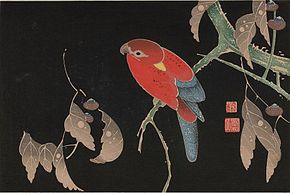Ishizuri-e
Ishizuri-e ( Japanese 石 折 絵 , dt. Stone abrasion picture ) is a special type of Japanese color, woodcut , which should imitate a stone abrasion .
Occasionally the term Takuhanga ( 拓 版画 , dt. Stone abrasion pressure ) is used for Ishizuri-e . This term is derived from Takuhon ( 拓本 , German stone abrasion ), which in turn goes back to the Chinese term Tàpiàn ( 拓片 , German stone abrasion ). In Japan, the term Mokutaku zuri-e ( 木 拓 折 絵 , German for wood and stone abrasion ) is also used for prints of this type . During the Edo period , the names Kuro-e (German black images ) and Shironuki-e (German white line images ) were also in use.
History and technology
Stone rubbing had already been invented in China during the Han Dynasty and had also come to Japan with Buddhist monks . For sale to pilgrims, in the Buddhist monasteries of Japan rubbings of carved reliefs of saints and the most popular sutras were made in stone until the end of the 19th century.
When rubbing ridge line structures, black lines appear on a light background, when stone carvings or stone engravings are rubbed off, white lines on a dark background. The effect of light contour lines on a dark background should be imitated by the Ishizuri-e. For this purpose, only the contour lines of the motif were cut into the wooden printing plates, so that after printing they stood out in the color of the paper from the colored background. For the printing process itself, it was easier to cut the printing plate as a negative of the motif to be printed and to transfer the printing ink from the colored printing plate to the paper than to drive the paper from the back into the recesses of the contours in order to color the protruding areas . However, F. Schwan mentions that Ishizuri-e were also printed this way.
Ishizuri-e are most often found in black, but other colors have also been used, such as blue (from around 1830 also Prussian blue ), green, yellow and red. In rare cases there are also multi-color prints or prints with hand-colored areas.
Shunshō, the general Guān Yǔ , around 1790, left Ishizuri-e, right as "normal pressure"
Artists and motifs
Artists who are known to print in the technique of Ishizuri-e are the ukiyo-e artist Nishimura Shigenaga , who was probably the first ukiyo-e artist to create designs for prints of this kind around 1750, his contemporary Okumura Masannobu , Isoda Koryūsai , Katsukawa Shunshō , Katsushika Taito II. (A Hokusai student) and Utagawa Hiroshige I , who made them in individual cases together with his student Hiroshige II. Utagawa Kunisada and Utagawa Kuniyoshi have occasionally designed tables of contents and title pages of technical series.
The representatives of the ukiyo-e mainly used the technique to depict motifs in the Chinese style. Her prints mostly show Chinese heroes, such as B. General Guān Yǔ from the story The Story of the Three Kingdoms , landscapes, depictions of plants and animals in the Chinese style and Chinese court ladies. The prints themselves do not belong to the ukiyo-e genre, but arose as a reaction to the renewed interest in Chinese art and culture in Japan in the mid / late 18th century.
The painter Itō Jakuchū , influenced by the Kanō and Rinpa Schools, used the Ishizuri-e technique for a series of impressive depictions of nature. His book “Jade Flowers in Mysterious Gardens”, published in 1768, contains 55 woodcuts with plants and animals that had been reprinted over and over again up to the beginning of the 20th century.
Individual Ishizuri-e are also known from Kikuchi Yōsai and some other artists. B. Scenes from the Chūshingura , landscapes in the Japanese style or in the Meiji period depict current political events.
But simple commercial graphics such as calendars were also produced as Ishizuri-e.
Individual evidence
- ↑ Entry on JAANUS, Terminology of Japanese Architecture & Art (English), accessed on November 10, 2011
- ↑ Schwan, p. 126
- ^ Gerhard Pommeranz-Liedtke. The wisdom of art. Chinese stone rubs. Insel-Verlag 1963.
- ↑ Schwan, p. 261
- ^ Marks, p. 95
literature
- Andreas Marks, Sonya Quintanilla: Dreams and Diversions. Seattle 2010, ISBN 978-0-937108-47-5 .
- Friedrich B. Schwan: Handbook Japanese Woodcut. Backgrounds, techniques, themes and motifs. Academium, Munich 2003, ISBN 3-89129-749-1 .




